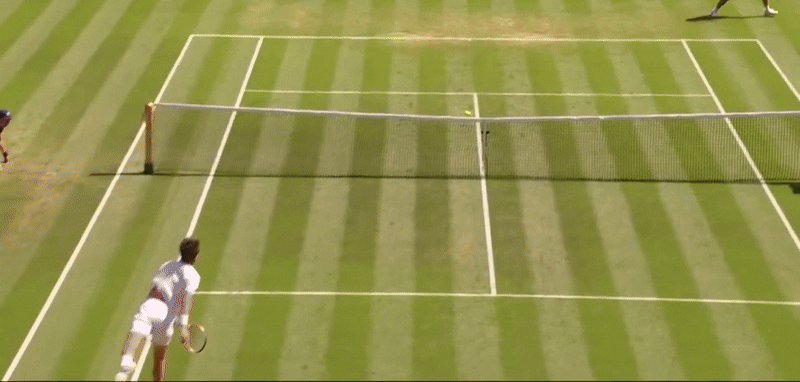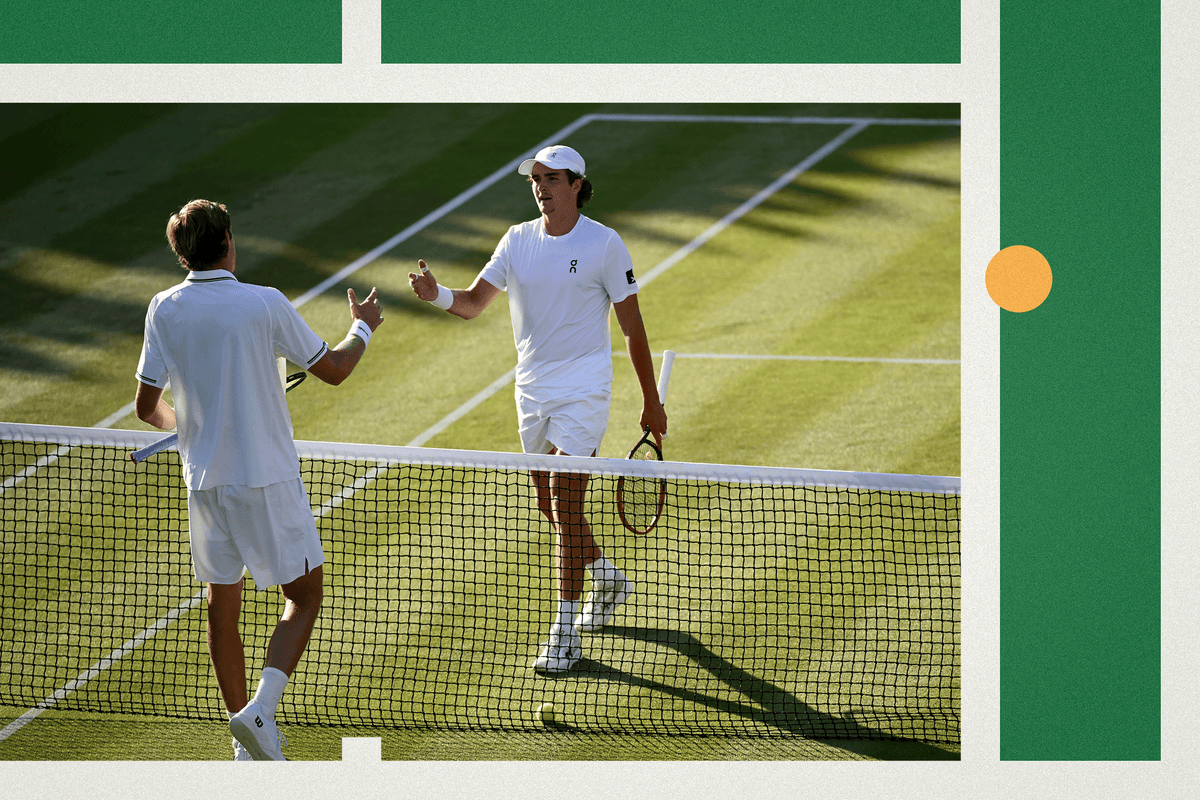An earlier version of this article misstated Nicolás Jarry’s nationality. He is Chilean, not Argentinian.
Follow The Athletic’s Wimbledon coverage
Welcome to the Wimbledon briefing, where The Athletic will explain the stories behind the stories on each day of the tournament.
On day five, a South American derby delivered, fortune favored a lucky loser and a second-week appearance meant more to one player than most.
Unexpected South American success in SW19
South America is having itself a pretty solid Wimbledon, just not in the way anyone might have expected.
When the tournament started, names like Fonseca or Haddad Maia seemed far more likely for runs to the second week than the surviving South Americans.
When the dust settled Friday evening, it had two players in the rounds of 16, in Nicolás Jarry of Chile and Solana Sierra of Argentina. It’s hard to overestimate how hard they had to get there. More on Sierra in a bit.
Jarry has barely won matches since he made the Italian Open final last year. He had to survive qualifying to earn a first-round date with Holger Rune, where he came back from two sets down to win. On Friday he beat João Fonseca, tipped for stardom when he is a little older, in four sets.
South America, a continent with a fervent tennis fan base, doesn’t get a proportional share of attention from the tours. North America has four 1,000-level events, just below the Grand Slams. Europe has five. There is one in Dubai and one in Doha, plus the WTA Tour Finals in Saudi Arabia, which is earmarked to get a 1,000 in the future. South America has zero.
Hopes for changing that may rest with Fonseca, a supreme talent from Brazil, the continent’s largest country, which has been without a big-time player since Gustavo Kuerten of Brazil a quarter-century ago. Tennis officials describe Fonseca as a potential game-changer.
That’s a lot to put on the shoulders of a teenager playing his first year of ATP Tour tennis. Fonseca has said he can feel the pressure. He knows what the sport and Brazilians at home and abroad are hoping for him.
It’s going to take a little time, and the third round of his first Wimbledon is a very respectable showing given that he has barely played on grass. Carlos Alcaraz only made the second round of his first Wimbledon in 2021, when he was 18. He made the third round of the French Open that year and the second round of the Australian Open.
Fonseca has made the last 32 here and in Paris, and the second round in Australia.
After the loss to Jarry, he spoke about how much he is learning about Grand Slam tennis and ups and downs of a five-set match. In Australia, he wondered whether he could last five sets. Now he knows he can, and that things can change very quickly.
“When you go to a Grand Slam, the players play differently,” he said. They are much more focused.”
He hears the noise, people saying he is the next Sinner or Alcaraz. He appreciates it, but is trying to stay inside his head, no matter what anyone else says.
“I’m just going to be me,” he said. “Some people understand that.”
Matt Futterman
At a Wimbledon of upsets, fortune favors the lucky loser
Now for Sierra. Amid all the chaos and upsets this week, it’s fitting that Friday saw another first for the underdog.
By beating Cristina Bucșa, Solana Sierra became the first lucky loser to reach the Wimbledon fourth round in the Open Era.
Lucky loser is the term given to players who lose in qualifying but then get a spot in the main draw when someone pulls out. So they are ranked outside the top 100, and have just lost to players in a similar postcode: the underdog’s underdog.
Sierra, 21 and from Argentina, is ranked No. 101. She had never won a Grand Slam match before this week, and only had eight wins at WTA Tour level with none on grass. She won 52 of 72 matches in 2024 on the third-tier ITF World Tennis Tour, but lost her only match on grass then too — in Wimbledon qualifying.
Solana Sierra celebrates becoming the first lucky loser to reach the Wimbledon fourth round since 1968. (Mike Hewitt / Getty Images)
Her run follows Eva Lys, another lucky loser, reaching the fourth round of the Australian Open in January, which is also an Open Era first.
Next up for Sierra is a last-16 match against Siegemund on Sunday. Who, appropriately enough for this Wimbledon, is ranked lower than her, at No. 104.
Yet another reminder of the depth in women’s tennis — and of the randomness of this year’s Wimbledon.
Charlie Eccleshare
Two very different Wimbledons for one player
At Wimbledon 2024, Russian tennis player Andrey Rublev reached the bottom of a very deep hole. In a first-round defeat to Argentina’s Francisco Comesana, Rublev obliterated his racket against his leg in frustration, as had become a habit for him.
Rublev, who has reached 10 major quarterfinals but never gone beyond the last eight at a Grand Slam, later discussed the impact of tennis on his mind at that time. He acknowledged that defeats had left him without control of his thoughts off the court, that he had reached a point when he did not “see the reason of living life.”
“Sometimes you learn the most from the worst cases,” Rublev said during an interview in Dubai earlier this year, another place of things were coming full circle. At the 2023 Dubai Tennis Championships, Rublev was defaulted from a match against Alexander Bublik after he screamed in the face of the line judge and was alleged to have used a Russian expletive. Rublev was defaulted from the match, and was stripped of his prize money and ranking points from the tournament, but they were later reinstated.
For Rublev, learning meant speaking to a psychologist, as well as reconfiguring his feelings about himself as a tennis player. No, he has never reached a Grand Slam semifinal. But going deep in the biggest events and being a reliable fixture at them? That makes him a good player. How can he put himself down about that, he would think.
That mindset explains why reaching the second week this year is such a milestone. Rublev returned to a site of one of his most painful moments, and has produced a calm, consistent level of tennis even while so many seeds around him are losing.
“Now this year, of course, I’m happy that I am able to win three matches,” he said in his news conference after beating Adrian Mannarino 7-5, 6-2, 6-3 to reach the fourth round.
“So I did better than last year. It’s already better than nothing.”
James Hansen
Other notable results on day five
- Aryna Sabalenka (1) was pushed all the way by Emma Raducanu and the Centre Court crowd, but came through 7-6(6), 6-4.
- Madison Keys (6) was bamboozled by a grass masterclass from Germany’s Laura Siegemund. Keys, who then skipped her media duties due to illness, lost 6-3, 6-3.
- Taylor Fritz (5) got past a bleeding elbow and a blistered foot to beat Alejandro Davidovich Fokina (26) in four sets, 6-4, 6-3, 6-7(5), 6-1.
- And Carlos Alcaraz (2) dropped a set to the all-attack German Jan-Lennard Struff, but came through 6-1, 3-6, 6-3, 6-4.
Recommended reading
Shot of the day

Day six matches you should actually watch
🎾 Men’s singles, 6 a.m. ET on ESPN/ESPN+
Flavio Cobolli (22) vs. Jakub Menšík (15)
A match between two rising prospects, who are high on talent but have struggled to produce it in tight moments at Grand Slams. Menšík has a gigantic serve but his forehand can get shaky in tight moments, while Cobolli can find himself overpowered despite his skill and flair.
🎾 Women’s singles, 11 a.m. ET on ESPN/ESPN+
Iga Świątek (8) vs. Danielle Collins
Świątek has a 7-2 record against Collins, but a strangely one-sided beef between them, which started with Collins calling Świątek insincere at the 2024 Olympic Games, gives this contest some bite. Collins also thrashed Świątek in their last meeting.
Wimbledon men’s draw 2025
Wimbledon women’s draw 2025
Tell us what you noticed on the fifth day…
(Top photo of TK: Getty Images; design: Eamonn Dalton / The Athletic)
